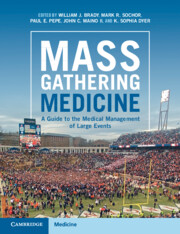Book contents
- Mass Gathering Medicine
- Mass Gathering Medicine
- Copyright page
- Dedication
- Contents
- Contributors
- Foreword
- Preface
- Chapter 1 An Introduction to Mass Gathering Medicine
- Chapter 2 Patient Care at Mass Gathering Events: Basic, Advanced, and Critical Care
- Chapter 3 Prediction of Medical Need and Event Risk Assessment at Mass Gathering Events
- Chapter 4 Medical Logistics and Operational Planning for Patient Care at Mass Gathering Events
- Chapter 5 Medical and Medical Support Staffing at Mass Gathering Events
- Chapter 6 Mass Gathering Medicine: Equipment and Planning Considerations
- Chapter 7 Incident Command System at Mass Gathering Events
- Chapter 8 Security and Other Nonmedical Logistical Support Issues at Mass Gathering Events
- Chapter 9 Understanding Local, State, and Federal Public Safety, Health Care, and Support Agencies
- Chapter 10 Common Themes and General Considerations across Mass Gathering Event Types
- Chapter 11 Mass Gathering Events: Youth, High School, Collegiate, Olympic, and Professional Sporting Events
- Chapter 12 Mass Gathering Events: Music Concerts and Festivals
- Chapter 13 Mass Gathering Events: Motor Sport Events
- Chapter 14 VIP and Executive Medicine Considerations at Mass Gathering Events
- Chapter 15 Mass Gathering Events: Community Events
- Chapter 16 Mass Gathering Events: Endurance Athletic Events
- Chapter 17 Mass Gathering Events: Extended Duration Events
- Chapter 18 At-Risk Populations within Mass Gathering Events
- Chapter 19 Crowd-Related Considerations at Mass Gathering Events: Management, Safety, and Dynamics
- Chapter 20 Civil Unrest and Terrorism Involving Mass Gathering Events
- Chapter 21 Impact of Weather and Climate Change on Mass Gathering Events
- Chapter 22 Occurrence of the Mass Casualty Incident at a Mass Gathering Event
- Chapter 23 Touring Medicine
- Chapter 24 Infectious Disease and Mass Gathering Medicine
- Chapter 25 Toxicology and Mass Gathering Medicine
- Chapter 26 Medicolegal Considerations in Mass Gathering Medicine
- Chapter 27 Business Considerations in Mass Gathering Medicine
- Index
- References
Chapter 20 - Civil Unrest and Terrorism Involving Mass Gathering Events
Published online by Cambridge University Press: 11 April 2024
- Mass Gathering Medicine
- Mass Gathering Medicine
- Copyright page
- Dedication
- Contents
- Contributors
- Foreword
- Preface
- Chapter 1 An Introduction to Mass Gathering Medicine
- Chapter 2 Patient Care at Mass Gathering Events: Basic, Advanced, and Critical Care
- Chapter 3 Prediction of Medical Need and Event Risk Assessment at Mass Gathering Events
- Chapter 4 Medical Logistics and Operational Planning for Patient Care at Mass Gathering Events
- Chapter 5 Medical and Medical Support Staffing at Mass Gathering Events
- Chapter 6 Mass Gathering Medicine: Equipment and Planning Considerations
- Chapter 7 Incident Command System at Mass Gathering Events
- Chapter 8 Security and Other Nonmedical Logistical Support Issues at Mass Gathering Events
- Chapter 9 Understanding Local, State, and Federal Public Safety, Health Care, and Support Agencies
- Chapter 10 Common Themes and General Considerations across Mass Gathering Event Types
- Chapter 11 Mass Gathering Events: Youth, High School, Collegiate, Olympic, and Professional Sporting Events
- Chapter 12 Mass Gathering Events: Music Concerts and Festivals
- Chapter 13 Mass Gathering Events: Motor Sport Events
- Chapter 14 VIP and Executive Medicine Considerations at Mass Gathering Events
- Chapter 15 Mass Gathering Events: Community Events
- Chapter 16 Mass Gathering Events: Endurance Athletic Events
- Chapter 17 Mass Gathering Events: Extended Duration Events
- Chapter 18 At-Risk Populations within Mass Gathering Events
- Chapter 19 Crowd-Related Considerations at Mass Gathering Events: Management, Safety, and Dynamics
- Chapter 20 Civil Unrest and Terrorism Involving Mass Gathering Events
- Chapter 21 Impact of Weather and Climate Change on Mass Gathering Events
- Chapter 22 Occurrence of the Mass Casualty Incident at a Mass Gathering Event
- Chapter 23 Touring Medicine
- Chapter 24 Infectious Disease and Mass Gathering Medicine
- Chapter 25 Toxicology and Mass Gathering Medicine
- Chapter 26 Medicolegal Considerations in Mass Gathering Medicine
- Chapter 27 Business Considerations in Mass Gathering Medicine
- Index
- References
Summary
Civil unrest or terrorism at mass gathering events can erupt with significant violence and multiple casualties. These are high-risk situations, not only because of physical casualties, but also because of ethical, political and psychological sequelae. Beyond specialized planning, multi-agency drills and proficient tactical medicine training, medical teams should co-create secured access and egress, alternative medical responses and rapidly-adapting coordination and secure communications with other agencies. Civil protests can escalate, especially when extremist groups infiltrate them. Multi-site violence and assaults can evolve, particularly in terroristic attacks. Key lessons include unrelenting vigilance until all participants have left the mass gathering scene in its entirety. Violence (bombs, shootings, vehicle attacks) will often erupt when mass gatherings are dispersing and considered over. Terrorists can also purposely target medical personnel or incite one event (fire, bomb, shooting) to create crushing stampedes or to herd crowds into more vulnerable areas where they can be further attacked more directly with other modern weapons. Terrorists often attack from elevated perches or generate “protracted suicide” incidents while holding hostages, including many severely-wounded. The resulting frustration, anger and guilt commonly can consume medical rescuers when beholding slaughtered innocents or simply because they were (appropriately) staged during containment of on-going violence.
Keywords
- Type
- Chapter
- Information
- Mass Gathering MedicineA Guide to the Medical Management of Large Events, pp. 284 - 304Publisher: Cambridge University PressPrint publication year: 2024



